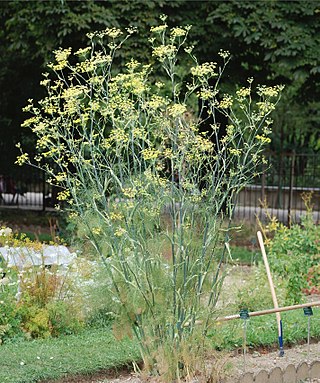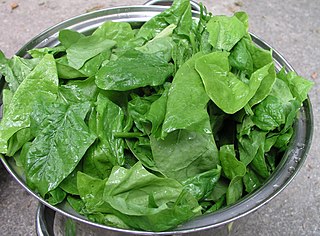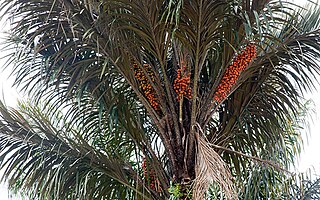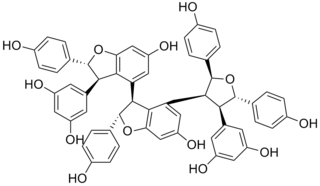
Fennel is a flowering plant species in the carrot family. It is a hardy, perennial herb with yellow flowers and feathery leaves. It is indigenous to the shores of the Mediterranean but has become widely naturalized in many parts of the world, especially on dry soils near the sea-coast and on riverbanks.

Foeniculum is a genus of flowering plants in the carrot family. It includes the commonly cultivated fennel, Foeniculum vulgare.

Gnetum gnemon is a species of Gnetum native to southeast Asia and the western Pacific Ocean islands, from Mizoram and Assam in India, south and east through Indonesia and Malaysia to the Philippines, Fiji, and Hawaii in the United States. Common names include gnetum, joint fir, two leaf, melinjo, belinjo, bago, and tulip.

Leaf vegetables, also called leafy greens, pot herbs, vegetable greens, or simply greens, are plant leaves eaten as a vegetable, sometimes accompanied by tender petioles and shoots. Leaf vegetables eaten raw in a salad can be called salad greens.
In botany, an umbel is an inflorescence that consists of a number of short flower stalks that spread from a common point, somewhat like umbrella ribs. The word was coined in botanical usage in the 1590s, from Latin umbella "parasol, sunshade". The arrangement can vary from being flat-topped to almost spherical. Umbels can be simple or compound. The secondary umbels of compound umbels are known as umbellules or umbellets. A small umbel is called an umbellule. The arrangement of the inflorescence in umbels is referred to as umbellate, or occasionally subumbellate.

(E)-Stilbene, commonly known as trans-stilbene, is an organic compound represented by the condensed structural formula C6H5CH=CHC6H5. Classified as a diarylethene, it features a central ethylene moiety with one phenyl group substituent on each end of the carbon–carbon double bond. It has an (E) stereochemistry, meaning that the phenyl groups are located on opposite sides of the double bond, the opposite of its geometric isomer, cis-stilbene. Trans-stilbene occurs as a white crystalline solid at room temperature and is highly soluble in organic solvents. It can be converted to cis-stilbene photochemically, and further reacted to produce phenanthrene.

Edible flowers are flowers that can be consumed safely. Flowers may be eaten as vegetables as a main part of a meal, or may be used as herbs. Flowers are part of many regional cuisines, including Asian, European, and Middle Eastern cuisines.

Astrocaryum vulgare is a very spiny palm native to the Guianas and the Amazon. It is species which has greatly benefited from deforestation, as it cannot grow in undisturbed rainforest. In Brazil it is considered typical of Pará state in the north of the lower Amazon. This plant has edible fruit.

Ligustrum vulgare is a species of Ligustrum native to central and southern Europe, north Africa and southwestern Asia, from Ireland and southwestern Sweden south to Morocco, and east to Poland and northwestern Iran.
The Seinan Gakuin University Biblical Botanical Garden is a Biblical garden, one of a number botanical gardens located across the campus of Seinan Gakuin University, Nishijin 6-2-92, Sawara-ku, Fukuoka, Fukuoka, Japan. It is open daily.

(Z)-Stilbene is a diarylethene, that is, a hydrocarbon consisting of a cis ethene double bond substituted with a phenyl group on both carbon atoms of the double bond. The name stilbene was derived from the Greek word stilbos, which means shining.
Fructus is a legal term used in Roman law to describe goods naturally created by other property. In the most traditional understanding, this encompasses literal fruit of various plants, but also goods taken from animals such as milk or wool. There is some debate whether profits arising from other legal actions, such as loan interest, can be considered fructus – ancient jurisprudents usually strayed from such interpretations, but did argue to treat such profits in analogical ways.

α-Viniferin is a stilbene trimer. It can be isolated from Caragana chamlagu and from Caragana sinica and from the stem bark of Dryobalanops aromatica. It is also present in relation to resistance to Botrytis cinerea and Plasmopara viticola in Vitis vinifera and Vitis riparia.It has been shown to inhibit acetylcholinesterase.

Kobophenol A is a stilbenoid. It is a tetramer of resveratrol. It can be isolated from Caragana chamlagu, from Caragana sinica and from Carex folliculata seeds.

Auriscalpium vulgare, commonly known as the pinecone mushroom, the cone tooth, or the ear-pick fungus, is a species of fungus in the family Auriscalpiaceae of the order Russulales. It was first described in 1753 by Carl Linnaeus, who included it as a member of the tooth fungi genus Hydnum, but British mycologist Samuel Frederick Gray recognized its uniqueness and in 1821 transferred it to the genus Auriscalpium that he created to contain it. The fungus is widely distributed in Europe, Central America, North America, and temperate Asia. Although common, its small size and nondescript colors lead it to be easily overlooked in the pine woods where it grows. A. vulgare is not generally considered edible because of its tough texture, but some historical literature says it used to be consumed in France and Italy.

δ-Viniferin is a resveratrol dehydrodimer. It is an isomer of epsilon-viniferin. It can be isolated from stressed grapevine leaves. It is also found in plant cell cultures and wine. It can also be found in Rheum maximowiczii.

Miyabenol C is a stilbenoid. It is a resveratrol trimer. It is found in Vitis vinifera (grape), in Foeniculi fructus, in Caragana sinica.
(+)-Thujan-3-ol dehydrogenase (EC 1.1.1.323, d-3-thujanol dehydrogenase, TDH) is an enzyme with systematic name (+)-thujan-3-ol:NAD(P)+ oxidoreductase. This enzyme catalyses the following chemical reaction

Mesir Macunu is a traditional Turkish sweet associated with the city of Manisa. Earlier versions of Mesir macunu were not sweet, but rather spicy in flavor.
Phytoecia rufipes is a species of beetle in the family Cerambycidae. It was described by Olivier in 1795. It has a wide distribution in Europe and the Middle East. It feeds on Foeniculum vulgare.














